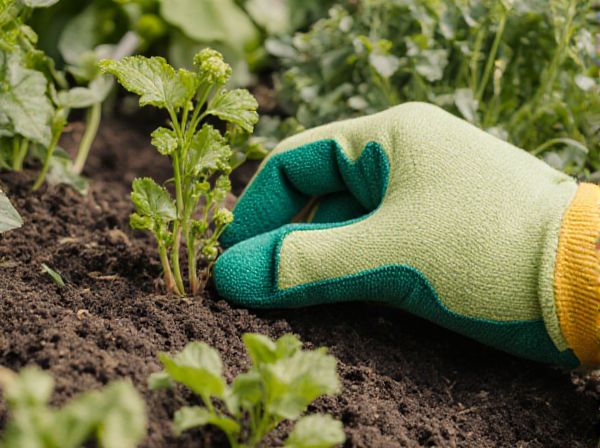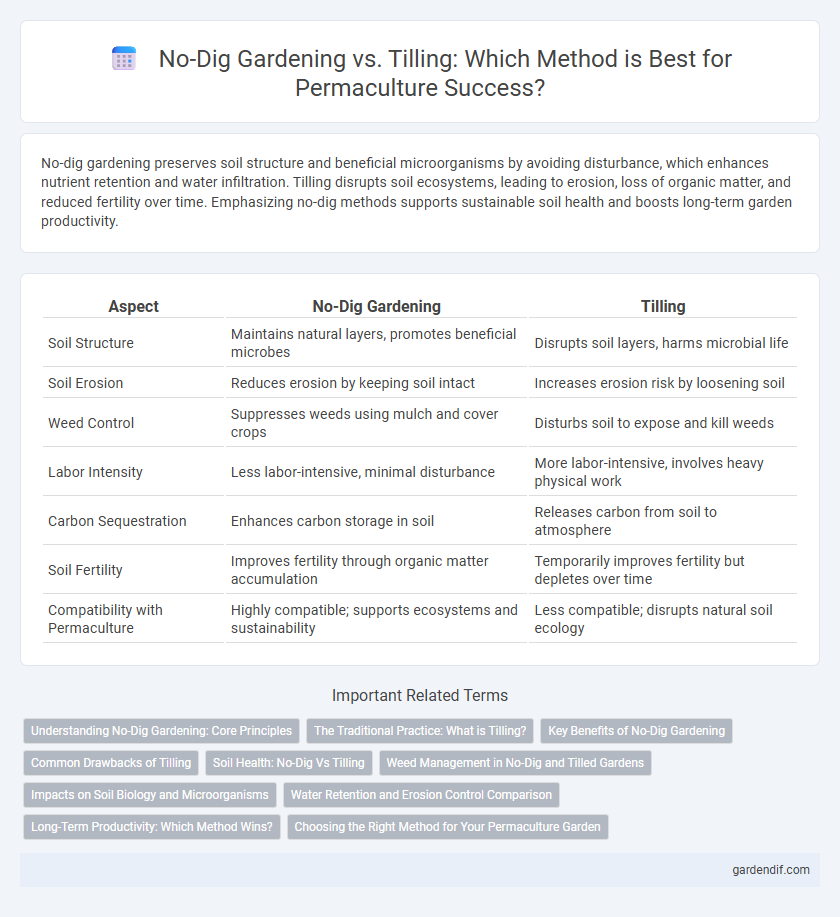
No-Dig Gardening vs Tilling Illustration
No-dig gardening preserves soil structure and beneficial microorganisms by avoiding disturbance, which enhances nutrient retention and water infiltration. Tilling disrupts soil ecosystems, leading to erosion, loss of organic matter, and reduced fertility over time. Emphasizing no-dig methods supports sustainable soil health and boosts long-term garden productivity.
Table of Comparison
| Aspect | No-Dig Gardening | Tilling |
|---|---|---|
| Soil Structure | Maintains natural layers, promotes beneficial microbes | Disrupts soil layers, harms microbial life |
| Soil Erosion | Reduces erosion by keeping soil intact | Increases erosion risk by loosening soil |
| Weed Control | Suppresses weeds using mulch and cover crops | Disturbs soil to expose and kill weeds |
| Labor Intensity | Less labor-intensive, minimal disturbance | More labor-intensive, involves heavy physical work |
| Carbon Sequestration | Enhances carbon storage in soil | Releases carbon from soil to atmosphere |
| Soil Fertility | Improves fertility through organic matter accumulation | Temporarily improves fertility but depletes over time |
| Compatibility with Permaculture | Highly compatible; supports ecosystems and sustainability | Less compatible; disrupts natural soil ecology |
Understanding No-Dig Gardening: Core Principles
No-dig gardening emphasizes preserving soil structure and promoting biodiversity by avoiding soil disturbance, which helps maintain beneficial microorganisms and earthworm populations. This method relies on layering organic materials as mulch, enhancing moisture retention and nutrient cycling without disrupting mycorrhizal networks. Core principles include minimal soil disturbance, continuous ground cover, and building soil fertility through natural composting and mulching techniques.
The Traditional Practice: What is Tilling?
Tilling is the traditional agricultural technique involving turning over the upper layer of soil to prepare garden beds by loosening soil, burying crop residues, and controlling weeds. This practice disrupts soil structure, often leading to erosion, reduced microbial activity, and loss of organic matter. Contrasting with no-dig gardening, tilling can accelerate soil degradation despite its effectiveness for immediate soil aeration and seedbed preparation.
Key Benefits of No-Dig Gardening
No-dig gardening enhances soil structure by preserving earthworm activity and beneficial microbes, essential for nutrient cycling and plant health. It significantly reduces soil erosion and compaction compared to traditional tilling, maintaining optimal moisture retention and root development. This method also boosts carbon sequestration, supporting sustainable agriculture and long-term soil fertility.
Common Drawbacks of Tilling
Tilling disrupts soil structure, leading to erosion and loss of vital organic matter. It increases the exposure of soil microorganisms to air, resulting in reduced microbial activity essential for nutrient cycling. Frequent tilling compacts deeper soil layers, hindering root penetration and water retention, which negatively impacts plant health and yields.
Soil Health: No-Dig Vs Tilling
No-dig gardening enhances soil health by preserving crucial microorganisms, earthworms, and fungal networks that improve nutrient cycling and soil structure. Tilling disrupts these beneficial organisms, leading to increased erosion, loss of organic matter, and reduced soil fertility over time. Maintaining an undisturbed soil ecosystem through no-dig methods promotes long-term sustainability and resilient plant growth.
Weed Management in No-Dig and Tilled Gardens
No-dig gardening suppresses weeds by maintaining a thick layer of organic mulch that blocks sunlight, preventing weed seed germination and encouraging beneficial soil organisms. In contrast, tilling disturbs the soil, which can bring dormant weed seeds to the surface and promote their growth, often requiring more frequent weeding or herbicide use. Over time, no-dig methods improve soil structure and biodiversity, naturally enhancing weed resistance without the disruption caused by tilling.
Impacts on Soil Biology and Microorganisms
No-dig gardening preserves soil structure and promotes diverse microbial communities by minimizing disturbance, which enhances nutrient cycling and soil health. Tilling disrupts fungal networks and soil aggregates, leading to reduced microbial biomass and increased oxidation of organic matter. Maintaining undisturbed soil layers supports beneficial microorganisms essential for resilient and productive ecosystems in permaculture systems.
Water Retention and Erosion Control Comparison
No-dig gardening enhances water retention by maintaining soil structure and organic matter, reducing evaporation and allowing better infiltration compared to tilling, which disrupts soil layers and accelerates moisture loss. No-dig methods reduce erosion by preserving root networks and microbial communities that stabilize the soil, while tilling exposes soil to wind and water, increasing erosion risks. Studies show no-dig systems can improve soil organic matter by up to 25%, significantly enhancing both water retention and erosion control over conventional tillage.
Long-Term Productivity: Which Method Wins?
No-dig gardening boosts long-term productivity by preserving soil structure, enhancing microbial activity, and reducing erosion compared to traditional tilling, which disrupts soil layers and depletes organic matter. Studies reveal no-dig beds improve water retention and nutrient cycling over time, leading to healthier plant growth and sustained yields. Permaculture systems favor no-dig methods for maintaining soil health and ecosystem balance essential for continuous productive harvests.
Choosing the Right Method for Your Permaculture Garden
No-dig gardening preserves soil structure, promotes beneficial microbial activity, and reduces erosion, making it ideal for permaculture systems focused on sustainability. Tilling disrupts soil ecosystems and can lead to nutrient loss but may be necessary for initially breaking compacted or heavily infested soils. Selecting the right method depends on soil condition, long-term goals, and the balance between soil health and practicality within your permaculture design.
No-Dig Gardening vs Tilling Infographic

 gardendif.com
gardendif.com